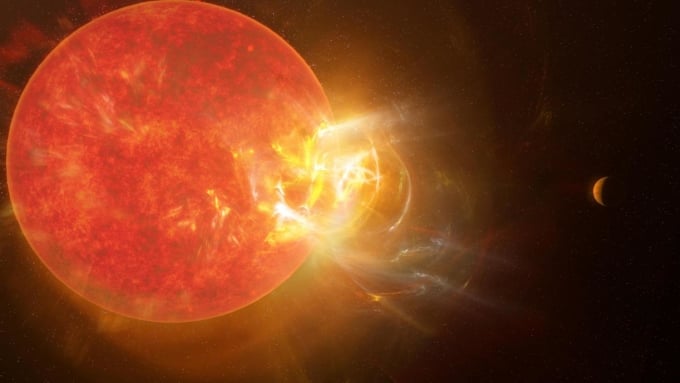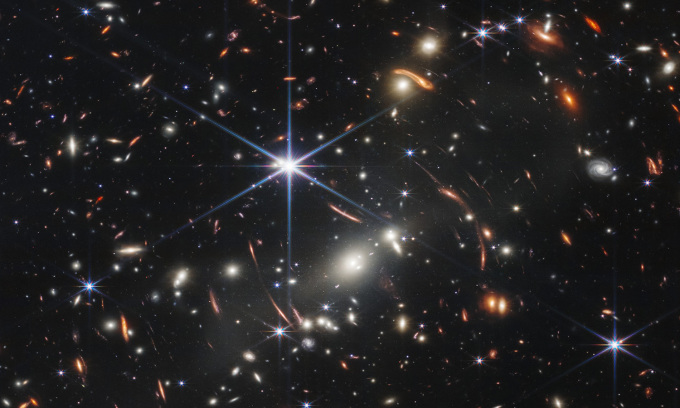To the naked eye, the night sky has more than 9,000 points of light, but this observable part is only a small corner of the universe.

Simulation of a flare erupting from the star Proxima Centauri. Photo: NRAO/S. Dagnello
The nearest observable (visible) star system is Alpha Centauri, about 4.25 light years from Earth. The closest star in this three-star system is Proxima Centauri, but as a red dwarf it is too faint to be observed without a telescope.
The most distant star visible to the naked eye is V762 Cas, a variable star 16,000 light years from Earth. Although it can be 100,000 times brighter than the Sun, its distance is so great that it can only be seen with human night vision under ideal conditions.
Every star that humans can see with the naked eye is much more massive than the Sun. Stars the size of the Sun or smaller are not bright enough to travel the light-year distance between them and Earth, and are therefore invisible.
V762 Cas is the most distant star visible to the naked eye, but it is not the most distant object visible without a telescope. That title belongs to the Andromeda Galaxy. Containing more than a trillion stars, the galaxy appears to the human eye as a large fuzzy mass the size of an outstretched fist. When you look at Andromeda, you are seeing light that traveled 2.5 million years ago.
In addition, some flashes and explosions temporarily increase in brightness to incredible levels, making them visible for a short time even at extremely great distances. For example, in 2008, the gamma-ray burst GRB 080319B was visible to the naked eye for about 30 seconds, even though it was more than 7.5 billion light years away. This means that when the light from the burst began to travel, the Solar System had not yet formed.

A distant galaxy captured by the James Webb Space Telescope. Photo: NASA/ESA/CSA/STScI
Telescopes allow us to see fainter objects because they collect more light, and more distant objects because they magnify images. But even with the most advanced ground- and space-based telescopes and the most extensive surveys, scientists have mapped less than 3% of the stars in the Milky Way and less than 1% of the galaxies in the observable universe.
To observe more distant objects, experts take advantage of a unique natural phenomenon: When light from a distant star or galaxy passes through a giant cluster of celestial objects, the cluster's gravity can magnify the image, sometimes by more than 10,000 times.
This phenomenon is called gravitational lensing. It has allowed astronomers to detect the most distant single star ever recorded, Earendel. Earendel formed just 900 million years after the Big Bang, making it part of the first generation of stars in the universe. Although it takes Earendel’s light 12.9 years to reach Earth, the star is now more than 28 billion light years away because the universe has been expanding at an accelerating rate since the Big Bang.
Also using gravitational lenses, astronomers used the James Webb Space Telescope to precisely measure the distance to JADES-GS-z13-0, the most distant galaxy ever recorded. JADES-GS-z13-0 is currently more than 33.6 billion light years away from Earth and formed when the universe was only 400 million years old. Experts say that humans will still be able to see even more distant cosmic objects in the future.
Thu Thao (According to Space )
Source link










![[Podcast] News on March 25, 2025](https://vphoto.vietnam.vn/thumb/402x226/vietnam/resource/IMAGE/2025/4/3/735b3003484942af8e83cbb3041a6c0c)

![[Podcast] News on March 26, 2025](https://vphoto.vietnam.vn/thumb/402x226/vietnam/resource/IMAGE/2025/4/3/c3d9c3c48b624fd9af79c13ff9e5c97a)
![[Podcast] News on March 27, 2025](https://vphoto.vietnam.vn/thumb/402x226/vietnam/resource/IMAGE/2025/4/2/de589137cda7441eb0e41ee218b477e8)
![[Podcast] News on March 28, 2025](https://vphoto.vietnam.vn/thumb/402x226/vietnam/resource/IMAGE/2025/4/2/71ad75b4b2494a89801803881cbac9ff)























































































Comment (0)